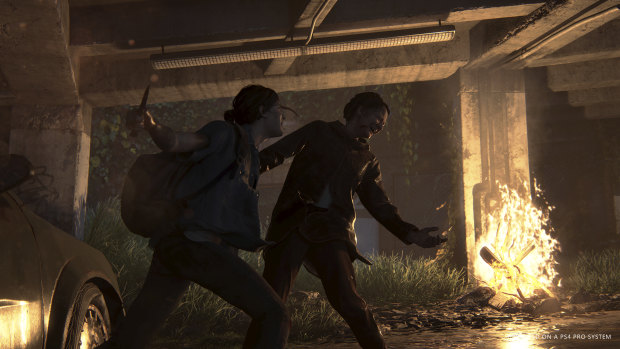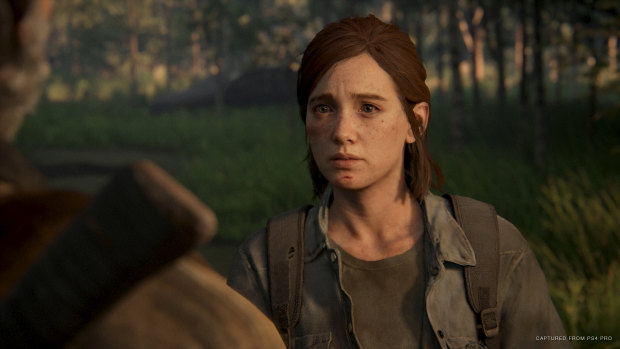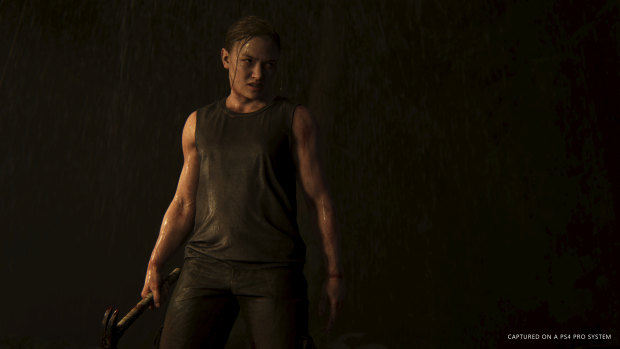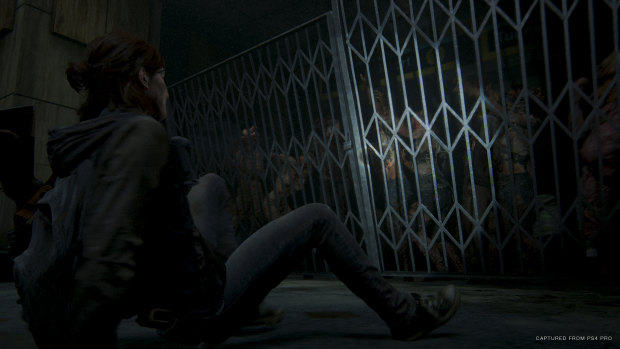- Review
- Technology
- Video games
This was published 5 years ago
Brutal and beautiful, The Last of Us sequel is a harrowing masterpiece
Spoiler warning: This review contains discussions of narrative themes from throughout The Last of Us Part II.
By Tim Biggs
With terrible violence and stunningly realised characters, The Last of Us Part II deconstructs the common video game concept of the "good person who does bad things", in a moving tale where enemies are redeemed, heroes defeat themselves and conflict persists not by irreconcilable differences but by ignorance and hate.
Heartbreakingly grim and powerfully optimistic, the game continues developer Naughty Dog's streak of unparalleled cinematic storytelling paired with slick and satisfying gameplay which — while filled with very video gamey abstractions — invests you in this epic, beautiful and astonishingly brutal journey.

Ellie is on a mission for revenge in The Last of Us Part II.
The world of The Last of Us Part II — mostly in ruins after the global outbreak of an infectious parasitic fungus — bears a striking resemblance to the late American frontier. And like writer Cormac McCarthy, Naughty Dog uses this lawless setting to bring baser human tendencies to the fore. The game sees Ellie, now 19, emotionally distant but funny and strong willed, exploring the splendour and horror of a largely uncivilised world while enmeshed in a cycle of violence she won't or can't escape.
If I can be reductive, given the sheer magnitude of the various stories told over this close-to-30-hour saga, this is a game about hate, in its many self-destructive manifestations — vengeance, fear, prejudice — and the wonderful potential we overlook or destroy by indulging in it. The physical violence in this game can be shocking and grotesque, but the most stomach-churning impacts come from the quieter moments, and the haunting things the characters say and do to their friends.
After their trials in the first game we find Ellie and father figure Joel living a comparatively cheerful life in a new colonial-style town in Wyoming, complete with electricity and filled with children playing in the streets. But outside the city walls much of the country is still infested with the deadly mushroom-faced former humans taken over by the infection and, even deadlier, other people with their own ways of living. When a figure from the past invades this picturesque setting and murders someone close to Ellie, she races to Seattle hell-bent on revenge but steps into something much more complicated.
Most of your time will be spent exploring overgrown and ruined locations, chatting to companion characters and following absorbing side-stories through found notes and diaries, all the while grabbing whatever useful garbage you can and using limited resources to decide what makeshift equipment to fashion. Will you build an exploding floor trap, or hammer some scissors through a baseball bat to make it easier to obliterate your next victim's face and avoid a dangerous and resource-intensive shootout?

Combat's safest when you're stealthy, but sometimes you need to get up close.
Yes the violence here is grusome and frequent, and made more upsetting by the fact that human enemies will talk to you and each other, calling by name and shrieking in anguish when you kill their friends. It's probably the only game in which I've hesitated to use more powerful weaponry because I knew what it would do to flesh and bone.
In a video game sense the combat — which relies heavily on staying hidden and picking enemies off one at a time — is thrilling. You'll need to adapt your strategies to deal with sightless but echolocating "clicker" zombies, deranged sprinting infected humans, regimented soldiers and a new faction specialising in stealth tactics; sometimes taking on a mix of these at once. In a narrative sense of course, the killing is unsettling as the moral calculus of justifiable revenge becomes increasingly unstuck.
The location design is one of highlights of this game, with an incredibly detailed and believably lived-in world featuring places we recognise — from suburban coffee shops to city office buildings to a children's museum exhibit — transformed by the reclamation of nature, the aberration of toxic fungus or the rough utility of soldiers and survivors. The influence of Naughty Dog's Uncharted adventures can be felt in semi-open exploration sections and exciting set-pieces — like a boat ride through waterways that now flow through crumbling underground car parks — which nicely complements the tense fighting and slower-pace environmental storytelling.
The character work and performances are also incredible, with three dimensional people capable of both soulful compassion and atrocious harm. Before this game the most recent story we saw involving Ellie was Left Behind; a tale that focused on a character-defining event from her childhood. There the subtlety of Naughty Dog's storytelling, and its sensitivity in developing Ellie as a young gay woman, allowed for some ordinarily tired coming-of-age tropes to be reinvigorated, and reconnected with their universality.

Ellie is a complex character, though features a lot of similarities to protagonists of American westerns.
That same method shines in The Last of Us Part II, not only because Ellie's frequently cast in the stereotypically "male" role when facing conflicts we recognise from decades of film and TV (with her femininity and sexuality never tokenised or diminished), but with the other characters too.
From Joel's continued moral conflict to Ellie's loyal but independent love interest Dina, the writing has a way of slicing through expectations and conventions to lend common struggles and hardships — often robbed of their power by oppressive and gauche tropes — some of the impact they have in real life. This is especially so with Abby — the target of Ellie's vengeful rage — a physically powerful woman driven by a history and conflicts of her own.

Abby plays an important and surprising role in the game's story.
This is a much longer and consequently less neat story than the original. In many ways that's to the game's benefit as it allows for some large-scale narrative and gameplay risks that mostly pay off, as well as joyful flashbacks and sobering focus shifts that are expertly timed to drive home the central perspectivist themes: how can you justify killing people you don't know? On the other hand the middle does sag, as an unexpected twist halfway through makes a big impact but also necessitates a slow few hours of exposition.
I can't say the narrative arc and eventual payoff is quite as affecting as in the first game. In the moment I was pretty much constantly caught up in the tension, the awe, the horror, the moments of levity and tenderness. But upon reflection there are some narrative niggles and spots where the game's incredibly high ambition isn't completely met.

Infected of all shapes and sizes are a frequent threat.
That said, this is an essential continuation for players of the first entry — the fallout from part one's ending, as well as the interesting parallels and contrasts between Ellie's experience of grief versus Joel's, is worth the price of admission alone — while also being a blockbuster game that you just can't help but marvel at, from the way flashlights play off the rain to the badassery of eliminating a militia squad with a bow while prone in the grass.
Naughty Dog should also be commended for its accessibility toolset, which as far as I've seen is groundbreaking in the mainstream game space, with preset configurations for players with vision, hearing or motor difficulties that are offered proactively when you start the game. For example the vision preset reads notes and instructional text aloud, highlights characters and objects in primary colours, emphasises audio cues in combat and navigation, makes a stealthy approach to combat easier and gives players the option to skip puzzles.
This is a singular game that blends cutting edge technology and silky big-budget design with stellar cinematic and literary storytelling. Of course the story can't strictly compare to most accomplished films or books, just like the gameplay might not satisfy fans of pure fantastical shooters, but the end result is nonetheless breathtaking.
I cried reading a random note left by a mother trying to raise her child in a most dangerous place, as well as during a particularly happy scene with Joel during Ellie's birthday, and unlike most video games some the biggest narrative moments are when the characters don't say a word. This is a game that really does look for the light, even if it spends most of its time examining the darkness.
The Last of Us Part II is out now on PlayStation 4.